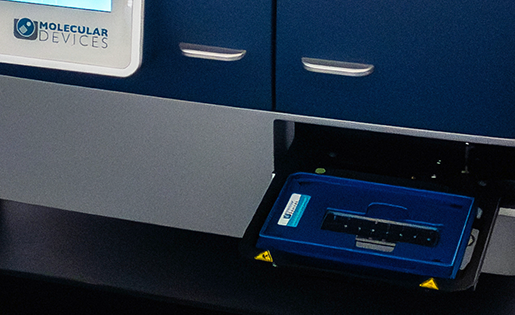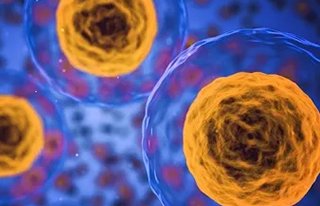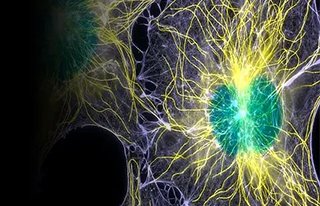ELISA、DNA・タンパク質の定量、細胞生存率、遺伝子発現など、
お好みのアプリケーションを使いやすいリーダーで実行
SpectraMax® MiniマルチモードマイクロプレートリーダーはUV-Vis吸光、蛍光、発光の3つの検出モードを搭載しています。ユーザーが必要に応じて簡単に2モードから3モードにアップグレード可能なため、ELISA、DNA・タンパク質の定量、細胞生存率、遺伝子発現など、お好みのアプリケーションに応じて、感度や性能に妥協のなくお使いいただけます。
また、付属のSoftMax® Pro ソフトウェアにより、迅速なデータの取得と解析が可能となり、短時間でより多くの成果を達成することができます。
SpectraMax Miniマルチモードマイクロプレートリーダーの特長
-

お求めやすい価格
30年以上にわたる経験と技術を、手軽でコンパクトなマルチモードリーダーに詰め込みました。
-

付け替えが容易なフィルターキューブ
必要に応じて蛍光、発光を簡単に使い分けることができるフィルターキューブを採用しています。
-

バックグラウンドノイズの低減
光学系にはキセノンフラッシュランプを採用しました。バックグラウンドの少ない超冷却光電子増倍管(PMT)検出器を搭載し、高感度と広いダイナミックレンジを実現しています。
-
使い方は簡単
トレーニング、データ生成、データ解析の時間を節約し、早く結果を出すことができます。
-
拡張された波長範囲
キセノンフラッシュランプを採用したことにより、ハロゲンでは不可能な紫外域で試料を励起することが可能です。
-
親しみやすいデザイン
使いやすさを追求し、ユーザーがアプリケーションを素早く、スムーズに実行するために必要な機能がすべて備わっています。
-
AutoPMTテクノロジー
独自のAutoPMT機能が幅広い濃度の試料を調製し、1枚のプレートで読み取ることができるため、飽和(または信号消失)を回避しつつ、時間とコストを削減することができます。
-
「SpectraDrop 微量サンプル測定プレート」でより少量のDNA、RNA、タンパク質をより迅速に定量
卓上型マイクロプレートリーダーのためのマイクロボリュームソリューション SpectraDrop™微量サンプル測定プレートは少量測定のためのハイスループットソリューションを実現します。革新的なデザインにより、サンプル調製時間を短縮し、2 µLという少量のDNA、RNA、タンパク質サンプルに対するラボの生産性を高めることができ、吸光、蛍光測定モードに対応します。マイクロプレートのフォーマットは均一で再現性のある分析を保証し、Molecular Devices 製StakMax®マイクロプレートスタッカーとシームレスに統合することで研究能力を向上させることができます。
詳しくはこちら
対応アプリケーション
-
吸光度

吸光度検出の仕組み、測定方法、濃度の算出方法など、吸光度検出のすべてをご紹介します。また、ELISA、核酸やタンパク質の定量法、微生物の増殖など、一般的な吸光度アプリケーションやアッセイに関する情報も提供しています。
吸光度を見る > -
セルへルス

細胞生存率アッセイは、細胞の健全性の指標としてATPや代謝酵素活性などの様々な細胞マーカーを測定します。様々な細胞毒性アッセイを含む細胞生存能と細胞増殖のアッセイの多くは、マイクロプレートリーダーを用いて検出されます。さまざまな検出モードを用いた生存率アッセイがあり、それぞれにメリットがあります。細胞毒性アッセイや細胞生存率アッセイは、薬剤やその他の治療法の効果を評価するためにしばしば使用され、新しい治療法を探索するための貴重なツールであると同時に、正常な細胞がどのように機能するかについての理解を深めるためのものでもあります。
セルヘルスを見る > -
細胞シグナル

細胞シグナリングにより、細胞は環境に応答し、また他の細胞とコミュニケーションをとることができます。細胞表面に存在するタンパク質は、シグナル伝達経路を構成する一連のタンパク質間相互作用と生化学反応を介して、周囲からのシグナルを受け取り、細胞内に情報を伝達することができます。多細胞生物は、細胞や組織の適切な成長、調節、機能を調整するために、広範なシグナル伝達経路に依存しています。細胞間あるいは細胞内のシグナル伝達に異常が生じると、不適切な細胞応答が癌やその他の疾患を引き起こす可能性があります。
細胞シグナルを見る >
その他のアプリケーション
SpectraMax Mini マルチモードマイクロプレートリーダーの仕様
| 一般仕様 | |
| 寸法(インチ) | 15.75 (奥行) x 12.60 (幅) x 13.78 (高さ) |
|---|---|
| 寸法(cm) | 40 (奥行) x 32 (幅) x 35 (高さ) |
| 電力要件 | 24 V の外部DC 電源(100 ~ 240 V AC、50 / 60 Hz に適合) 最大消費電力160 W |
| 重さ | ≤ 40 ポンド (18 kg) |
| ロボット対応 | 対応可能 |
| 吸光度、蛍光、ルミネセンス | ◯ |
| 吸光度測光範囲 | |
| 波長範囲 | 200–1000 nm |
| 波長選択 | 1.0nm刻み |
| 波長帯域幅 | ≤ 5 nm(半値全幅) |
| 波長正確性 | 波長範囲で±2 nm |
| 波長精度(再現性) | ± 0.2 nm |
| 測光学範囲 | 0–4.0 OD |
| 光学解像度 | 0.001 OD |
| 光学正確性、直線性 | < ±0.006 OD ±1.0%, 0–3 OD |
| 迷光 | ≤ 0.05% at 230 nm |
| 測光精度(再現性) | < ±0.003 OD ±1.0%, 0–3 OD |
| 蛍光強度性能 | |
| 波長範囲 | 250–850 nm |
| ダイナミックレンジ | > 6 decades |
| 感度(フルオレセイン) | 1 pM | 発光性能 |
| 波長範囲 | 300–650 nm |
| ダイナミックレンジ | > 7 decades |
| 感度(ATP) | 2 pM |
| クロストーク | <0.1%(白色96ウェルハーフエリアマイクロプレート) |
| 一般的な性能 | |
| プレートフォーマット | 6、12、24、48、96、384ウェルプレート ANSI/SLAS |
| 光源 | 高エネルギーキセノンフラッシュランプ2灯 |
| 振盪機能 | 直線状、環状、8の字状 |
| 測定対象 | マイクロプレート、キュベット(要アダプター) |
| 検出器 | 超低温光電子増倍管およびシリコンフォトダイオード |
| 温度制御 | (室温+4℃)〜45℃ |
| 温度の均一性 | ±1℃ @ 37℃ |
| 温度正確性 | ±2℃ @ 37℃ |
| スペクトルスキャン | 吸光 |
| エンドポイント測定 | 吸光、蛍光、発光 |
| カイネティック測定 | 吸光、蛍光、発光 |
| ウェルスキャン | 20×20以上 |
| 標準フィルターキューブ | |
| ダイクロイック | 405, 508, 555 |
| フィルター名 | FL-465, FL-535, FL-595 |
| フルオロフォア/アッセイ | クマリン誘導体(AMC)、AF350、フルオレセイン/FITC、アラマーブルー |
| 励起 | 360/35, 485/20, 535/25 |
| 蛍光 | 465/35, 535/25, 595/35 | オプションのフィルターキューブ |
| ダイクロイック | 310, 508, 610, 655, 765 |
| フィルター名 | FL-360, FL-565, FL-635, FL-680, FL-810 |
| フルオロフォア/アッセイ | トリプトファン、Nano orange/Quant IT タンパク質アッセイ、Alexa Fluor 594、Texas Red、Alexa Fluor 647/cy5、Alexa Fluor 750/cy7 |
| 励起 | 280/20, 465/35, 590/20, 625/35, 710/50 |
| 蛍光 | 360/35, 565/30, 635/25, 680/20, 810/40 |
詳細を見る